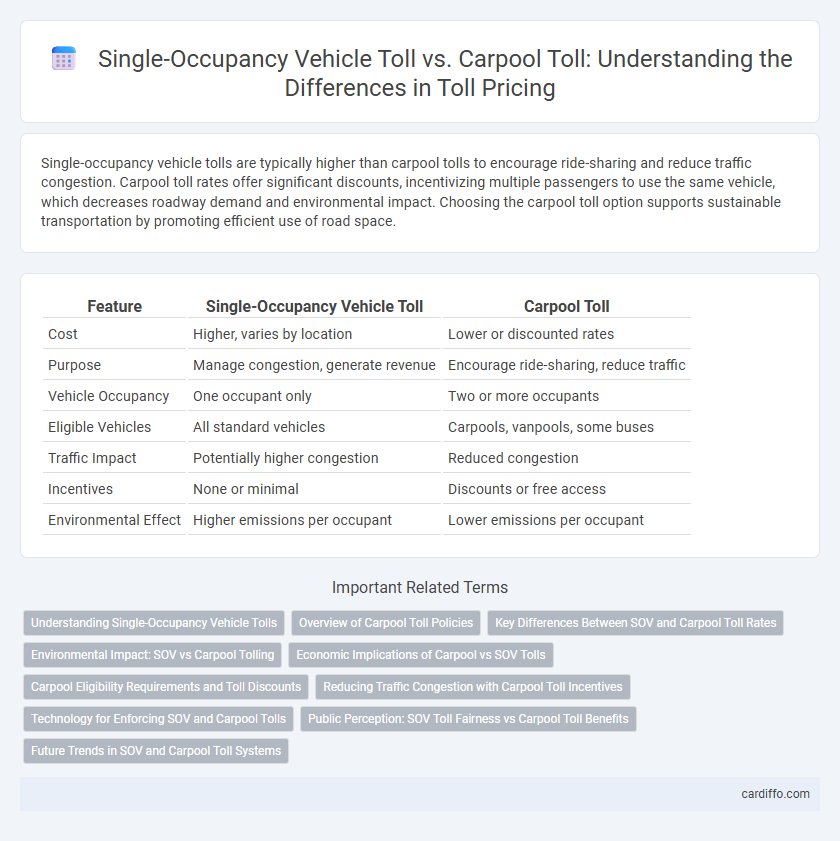Single-occupancy vehicle tolls are typically higher than carpool tolls to encourage ride-sharing and reduce traffic congestion. Carpool toll rates offer significant discounts, incentivizing multiple passengers to use the same vehicle, which decreases roadway demand and environmental impact. Choosing the carpool toll option supports sustainable transportation by promoting efficient use of road space.
Table of Comparison
| Feature | Single-Occupancy Vehicle Toll | Carpool Toll |
|---|---|---|
| Cost | Higher, varies by location | Lower or discounted rates |
| Purpose | Manage congestion, generate revenue | Encourage ride-sharing, reduce traffic |
| Vehicle Occupancy | One occupant only | Two or more occupants |
| Eligible Vehicles | All standard vehicles | Carpools, vanpools, some buses |
| Traffic Impact | Potentially higher congestion | Reduced congestion |
| Incentives | None or minimal | Discounts or free access |
| Environmental Effect | Higher emissions per occupant | Lower emissions per occupant |
Understanding Single-Occupancy Vehicle Tolls
Single-occupancy vehicle (SOV) tolls charge drivers who travel alone, encouraging carpooling and reducing traffic congestion on toll roads. These tolls are typically higher than carpool tolls to incentivize shared rides and lower emissions. Understanding the pricing structure of SOV tolls helps commuters evaluate cost savings when choosing carpool options.
Overview of Carpool Toll Policies
Carpool toll policies typically offer discounted or waived fees for vehicles carrying two or more occupants to encourage ride-sharing and reduce traffic congestion. These policies are implemented through High Occupancy Vehicle (HOV) lanes or express toll lanes, where toll rates for carpools are significantly lower compared to single-occupancy vehicles. Enforcement methods often include occupancy verification systems such as transponders with occupancy sensors or periodic manual checks to ensure compliance.
Key Differences Between SOV and Carpool Toll Rates
Single-occupancy vehicle (SOV) toll rates are generally higher than carpool toll rates to incentivize ridesharing and reduce traffic congestion. Carpool toll discounts vary by region but can range from 25% to 50% lower than SOV rates, promoting environmental sustainability by decreasing single-driver trips. Time-based pricing often applies, where peak-hour SOV tolls surge, while carpool vehicles may enjoy reduced or waived fees, emphasizing efficient road use.
Environmental Impact: SOV vs Carpool Tolling
Single-occupancy vehicle (SOV) tolls encourage reduced carbon emissions by discouraging solo driving, thereby lowering overall traffic congestion and air pollution. Carpool tolling promotes higher vehicle occupancy, which maximizes fuel efficiency per passenger and significantly decreases greenhouse gas emissions per trip. Implementing differentiated toll rates for SOVs versus carpools drives sustainable transportation choices, directly benefiting environmental conservation efforts.
Economic Implications of Carpool vs SOV Tolls
Carpool tolls reduce individual commuting costs by allowing multiple passengers to share a single toll fee, enhancing overall travel efficiency and lowering per-person expenses. Single-occupancy vehicle (SOV) tolls impose higher costs on solo drivers, which can discourage excessive use of private vehicles and promote carpooling as a cost-effective alternative. Economic implications include decreased roadway congestion, reduced fuel consumption, and potential increases in disposable income for carpool users due to savings on toll fees.
Carpool Eligibility Requirements and Toll Discounts
Carpool toll discounts apply to vehicles with a minimum of two or three occupants, depending on the specific tolling authority's eligibility requirements, which often mandate proof of occupancy such as valid carpool stickers or electronic toll transponders configured for multiple riders. Single-occupancy vehicles typically pay standard toll rates without discounts, while carpool vehicles benefit from reduced toll costs to incentivize ride-sharing and reduce traffic congestion. Eligibility verification may include occupancy audits or exemption from toll fees during designated carpool hours, enhancing cost savings for eligible high-occupancy vehicles.
Reducing Traffic Congestion with Carpool Toll Incentives
Carpool toll incentives reduce traffic congestion by encouraging multiple passengers to share vehicles, decreasing the number of single-occupancy vehicles on the road. Lower toll rates for carpools promote efficient use of highway space and reduce peak-hour traffic volume. Studies show that implementing carpool toll discounts can lead to significant declines in congestion-related delays and emissions.
Technology for Enforcing SOV and Carpool Tolls
Advanced electronic toll collection (ETC) systems utilize license plate recognition and transponder technologies to accurately differentiate single-occupancy vehicles (SOVs) from carpools, ensuring precise toll enforcement. Machine learning algorithms analyze real-time traffic patterns and vehicle occupancy data to detect violations without impeding traffic flow. Integration with mobile apps and vehicle-to-infrastructure (V2I) communication enhances compliance monitoring while minimizing manual enforcement costs.
Public Perception: SOV Toll Fairness vs Carpool Toll Benefits
Single-occupancy vehicle (SOV) tolls are often perceived as a fair method to reduce traffic congestion by encouraging drivers to carpool or use alternative transportation modes. Carpool toll benefits are viewed positively because they incentivize ride-sharing, lower emissions, and decrease roadway wear, fostering a sense of communal responsibility. Public perception varies, with some drivers seeing SOV tolls as punitive while recognizing carpool tolls as equitable and beneficial for overall traffic management.
Future Trends in SOV and Carpool Toll Systems
Future trends in single-occupancy vehicle (SOV) and carpool toll systems emphasize dynamic pricing models leveraging real-time traffic data to optimize congestion management and promote ride-sharing. Integration of advanced telemetry and AI-powered analytics will enable toll adjustments based on occupancy detection accuracy, encouraging higher carpool participation. Emerging policies may incorporate incentives such as reduced rates or priority lane access for carpool vehicles, fostering sustainable transportation and reducing urban emissions.
Single-occupancy vehicle toll vs carpool toll Infographic

 cardiffo.com
cardiffo.com